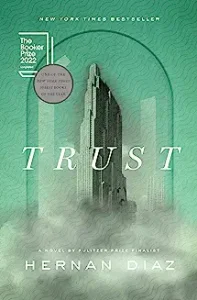Trust by Hernan Diaz 2022
This book stayed with me longer than many novels. At first puzzling and then thought-provoking, I was quite taken with Diaz’s technique though I’m not a big fan of meta-fiction. I was even more enthralled by his theme, or rather themes. One might choose that ‘trust’ refers to the faulty or self-deceiving memories that underlie our autobiographies. Or one might choose the history of capitalism, the accumulation of great wealth, or the distortions that the capital markets are vulnerable to. But for me, the primary theme is about the female identity and how it has been constrained, distorted, and controlled by the patriarchal society in which women have lived for centuries.
Spoiler alert: I found it both useful for my own understanding of the book to describe the plot in some details, so, Reader, be warned. The book begins as a standard novel about the world of Edith Wharton, Henry James, and Thomas Mann—19th C. New York—narrated by an omniscient third person telling the story of one Benjamin Rask, beginning in childhood, progressing through school and then marriage and a very successful financial career. The tragedy of his wife Helen’s madness, decline, and eventual death in a Swiss sanitorium appeared to be a straightforward, sad tale. Enter Andrew Bevel in the second chapter and his strange, first-person memoir interrupted at random intervals by incomplete notes, memos, and references and ending in a confusing, incomplete way. Enter Ida Portenza, the young daughter of an Italian immigrant anarchist, who lives with her father in poverty in Brooklyn but who manages to land a job as the amanuense of Bevel who hires her to convert his meandering thoughts and autobiographical details (Ah, that’s what Chapter 2 was about!) into a book focused on presenting a portrait of his recently deceased wife, Mildred, It seems that one Harold Vanner had published a novel which Bevel had taken as a thinly veiled account of his life in which Vanner had terribly wronged Mildred by writing that she had died insane in a Swiss sanitorium (Ah, that’s what Chapter 1 was about!). In the next chapter, Bevel has died and Ida is exploring the archives in the newly converted museum that had been Bevel’s Fifth Avenue mansion. There she discovers Mildred’s diary which makes it clear that Mildred, not Andrew, was the brains and the power behind Bevel’s financial success. This story is finally amplified and told in detail in the final chapter by Mildred herself, dying of cancer in a Swiss sanitorium. A brilliantly planned and constructed novel. Fiction at its best.
After focusing nearly exclusively on trying to understand the structure of the novel, I finally had the time to think about its message. Besides the clever and creative novelistic techniques, what was Diaz trying to show us? I think it was Helen/Mildred/Ida’s struggle to define herself in a world dominated and defined by men. Whether portrayed as mad by Vanner, or as a docile, loving, and empty-headed wife by Bevel, or as simply the vehicle for channeling a man’s words and thoughts, women were constrained or worse and were unable to express their inner feelings, talents, and capacities. Mildred and her biographer, Ida emerge in the mid-20th C as the model for the liberated modern woman, ready to lead and receive the recognition and credit they deserve.
Chosen as one of the New York Times 10 best books of 2022 and only the second novel by Diaz, this promises a brilliant and fascinating career to come.



